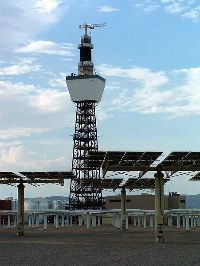How Much Solar Thermal Would Be Required to Provide 100% of Our Energy Needs?
I’ve often written about how astonishingly little of the Earth’s surface needs to be covered in a solar collecting technology, e.g., solar thermal, in order to provide 100% of the world’s energy needs. Linked above is a wonderful graphic that makes this clear.
Don’t get me wrong: the task of deploying that much solar thermal is not something that we can do overnight, but it sure provides something to think about. We receive 6000 times more energy from the sun every day than we need to supply all our energy needs. It sure seems a shame that we can’t come up with a way of making this happen, and that, as a consequence, we keep depleting our ever-shrinking supply of fossil fuels, while destroying our natural environment.


It’s obviously true that the world receives many times more solar energy than would be required to provide for our need for electricity, etc. The problem is that in any one place, it is an intermittent source of energy and very diffuse whereas we need reliable power 24 hours per day.
I recommend reading the book “Beyond Smoke and Mirrors…” by Burton Richter; he is a Nobel Prize-winning American physicist. In his book, he carefully explains the strengths and limitations of various sources of energy.
P.S.
Dr. Richter also explains that solar energy is much more efficient when used for heating than when used to produce electricity and points out the folly of providing tax incentives for solar electricity and not for solar heat. He also points out that it is even far more commonly used for heat than electricity, although I suspect that that may not be true in the U.S. However, in many countries, solar water heaters are ubiquitous.
“… solar energy is much more efficient when used for heating than when used to produce electricity”
I 100% agree, in fact I’ve been saying this for several years. You may be interested to know the UK has recognised the potential for solar, and other carbon neutral, heat sources and has recently introduced the ‘Renewable Heat Incentive (RHI) which does provide financial incentives for these heat sources.
Nick,
It’s certainly encouraging to learn that solar energy for heating is being encouraged in at least one place.
It’s also possible to use solar heat to power an absorption air conditioning system using the lithium bromide cycle; it’s been done and the equipment may actually be available. Whether that can be economically justified I don’t know. The solar heat for it requires a concentrating system, such as with parabolic trough mirrors, because to work well, an absorption system requires temperatures close to 100 C. And, absorption systems have a COP of slightly less than 1 whereas electric air conditioning can have a COP > 3.5. The equipment tends to be big and bulky.
The most common use of absorption air conditioning systems is with electrical generators for large buildings; the air conditioning system operates on the waste heat from the engines. But if the cost wouldn’t be excessive, it could be a good way to use solar heat.